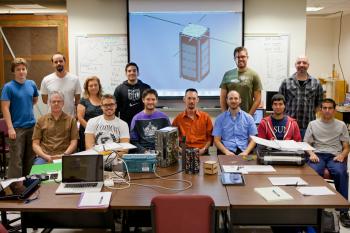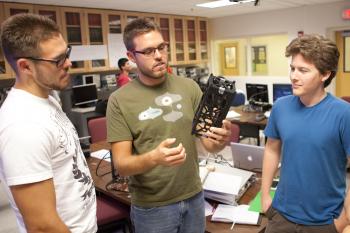Its name is CSUNSat1, and it’s what is known generically as a CubeSat—a micro satellite measuring 10×10x20 cm, roughly the size of a shoebox and weighing about five pounds. After designing, building and testing the CubeSat, the CSUN project team will work with NASA to get it launched into space.
“You’ll have your own satellite circling Earth,” explains Naomi Palmer, section manager for power and sensor systems at Jet Propulsion Laboratory.
 Last spring, as part of a design clinic, JPL collaborated with electrical and computer engineering professors Sharlene Katz, Jay Flynn and David Schwartz, plus six students in the department, on a CubeSat project. The aim was to teach the students what a CubeSat is, how it works, what it takes to fly one and what the micro-satellite can do. At the end of nine months, the team presented a working prototype, including a ground station, to JPL.
Last spring, as part of a design clinic, JPL collaborated with electrical and computer engineering professors Sharlene Katz, Jay Flynn and David Schwartz, plus six students in the department, on a CubeSat project. The aim was to teach the students what a CubeSat is, how it works, what it takes to fly one and what the micro-satellite can do. At the end of nine months, the team presented a working prototype, including a ground station, to JPL.
That project was only laying the groundwork for a larger and more ambitious CubeSat project, however. In August, Flynn, Katz and Schwartz, in partnership with JPL, were awarded a two-year, $200,000 NASA SmallSat Technology Partnership Grant. The grant also includes funds for JPL engineers and scientists to collaborate with the CSUN team. The purpose of the program is to develop and demonstrate new technologies employing the unique features of small spacecraft for science, exploration and space operations. The CSUN grant was one of just 13 awarded nationwide, out of more than 100 applications.
 CSUNSat1, as it’s been dubbed, will carry a JPL energy storage experiment into orbit about 500 miles above the earth. Over several months, it will downlink data from the experiment to a ground station on the roof of Jacaranda Hall on the CSUN campus. The CSUN team—consisting of over 20 seniors and graduate students; Katz, Flynn and Schwartz; plus Adam Kaplan from the computer science department—is responsible for construction of the satellite and design of the radio, sensor electronics and power system, along with the satellite’s main computer programming. The group will carry out all testing of the completed satellite and will also design, build and operate the ground station. JPL, with Palmer as the liaison, is responsible for design and construction of the experimental payload, which will validate a new technology that will allow longer missions farther from the sun.
CSUNSat1, as it’s been dubbed, will carry a JPL energy storage experiment into orbit about 500 miles above the earth. Over several months, it will downlink data from the experiment to a ground station on the roof of Jacaranda Hall on the CSUN campus. The CSUN team—consisting of over 20 seniors and graduate students; Katz, Flynn and Schwartz; plus Adam Kaplan from the computer science department—is responsible for construction of the satellite and design of the radio, sensor electronics and power system, along with the satellite’s main computer programming. The group will carry out all testing of the completed satellite and will also design, build and operate the ground station. JPL, with Palmer as the liaison, is responsible for design and construction of the experimental payload, which will validate a new technology that will allow longer missions farther from the sun.
“The students are getting a unique experience—the opportunity to build a satellite and get it launched and get signals from the ground station,” says Katz. “It’s not the kind of thing they get to do every day.”
The students’ participation will fulfill their senior or graduate project requirement.

Subscribe to this post's comments feed